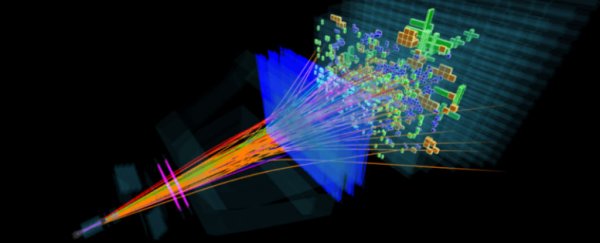Of the many unanswered questions that stand in the way of the Standard Model of physics being able to adequately explain the Universe and everything in it, the mystery of matter- antimatter asymmetry is one of the biggest.
The equal amounts of matter and antimatter produced by the Big Bang should have cancelled each other out, resulting in a Universe with barely any particles, and yet, here we are. Now, new results from a Large Hadron Collider detector at CERN could be our best chance at explaining the paradox of our own existence.
For a bit of background into our asymmetrical Universe problem, the laws of physics predict that for every particle of regular matter, there's an equal but opposite antiparticle.
That means for every negatively-charged electron, there's a positively charged positron. For every regular hydrogen atom, there's an anti-hydrogen atom.
If an antiparticle happens to find a regular particle, they will annihilate each other, releasing energy in the form of light.
The problem arises when we consider that the Standard Model of physics predicts that the Big Bang would have produced equal amounts of baryon particles in matter and antimatter forms - called baryonic matter and antibaryonic matter.
Baryons are a crucial type of subatomic particle, because you know those protons and neutrons that make up most of the mass of the visible matter in the Universe? They're baryons.
The fact that we ended up with so much more baryonic matter than antibaryonic matter in the Universe is a problem, because the equal amounts produced by the Big Bang should have instantly cancelled out almost everything, resulting in a Universe with barely any particles - just radiation.
The Standard Model does account for a tiny amount of asymmetry in baryon particles, but it certainly can't explain the overabundance we see of baryonic matter today.
So how did all that matter survive?
The violation of symmetry in the Universe implies that the laws of physics are not the same for matter and antimatter particles, and physicists have been trying to figure out where these laws could diverge - a phenomenon known as charge-parity (CP) violation.
Previous research has found evidence of CP violation in mesons - part of the hadron particle family - but to predict the amount of matter in the Universe as it exists today, we have to find it in baryons too.
For more than half a century, scientists have been searching for evidence of CP violation in baryons, and now, researchers working with one of the Large Hadron Collider (LHC) detectors at CERN in Switzerland appear to have finally found some.
Using the LHCb detector, the team produced enormous amounts of a specific type of baryon (the Λb0 baryon) and its antiparticle version (Λb0-bar), and observed how each decayed into a proton (or antiproton) and three charged particles called pions when smashed together.
"This process is extremely rare, and has never previously been observed," the team explains.
"The high production rate of these baryons at the LHC, and the specialised capabilities of the LHCb detector, allowed the collaboration to collect a pure sample of around 6,000 such decays."
The fact that these particles decay into separate components is important, because any significant difference - or asymmetry - between the quantities for matter and antimatter baryons would be the result of CP violation.
And that's exactly what the researchers found.
"The LHCb data revealed a significant level of asymmetries in those CP-violation-sensitive quantities for the Λb0 and Λb0-bar baryon decays, with differences in some cases as large as 20 percent," the team reports.
It's exciting stuff, and we could actually be on the verge of solving one of the most important mysteries in modern physics… but we're not there yet.
CERN reports that the statistical significance - how physicists measure the probability that the result hasn't occurred by chance - is at the level of 3.3 standard deviations, and you can only really claim a discovery once this value has reached 5 standard deviations.
Considering how successful the LHCb has proven in producing these baryon reactions so far, it's likely only a matter of time before we see the results strengthened or disproved.
And, as Chris Lee explains for Ars Technica, there's reason to hold out hope for that magic number 5:
"Particle physics results are dragged, kicking and screaming, out of the noise via careful statistical analysis; no discovery is complete until the chance of it being a fluke is below one in a million. This result isn't there yet (it's at about the one-in-a-thousand level).
So, it's promising, and at the rate the LHC is generating data, the asymmetry will either be quickly strengthened or it will disappear entirely. However, given that the result for mesons is well and truly confirmed, it would be really strange for this result to turn out to be wrong."
All we can say is watch this space, because the researchers are analysing a new, larger data set collected by the LHC as we speak. Hopefully we won't have to wait too much longer to see what they find.
The study has been published in Nature Physics.
